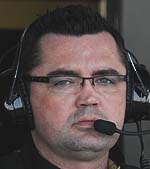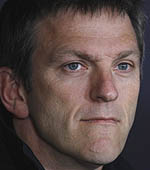


22/10/2012
NEWS STORY
 With the team's pre-season ambitions of fourth place in the Constructors' Championship all but secured, Team Principle Eric Boullier is readying the troops for an assault on breaching the top three as the final push for success continues...
With the team's pre-season ambitions of fourth place in the Constructors' Championship all but secured, Team Principle Eric Boullier is readying the troops for an assault on breaching the top three as the final push for success continues...
How is the team looking as we enter the final phase of the season?
Eric Boullier: I think if we look at the last two or three races objectively then we've had our difficulties, but we've also seen a clear step forward in terms of performance with the new exhaust system in Korea. The team did a brilliant job to bring such a significant upgrade to the race and make it work first time and there is still a lot more to come from this concept once we have had some more time to work with it. I think we should now be looking to push both cars into the top five during qualifying which will give us a much better chance of bringing home some good points in the fight for third place in the Constructors' Championship.
With just four races to go and a rapidly diminishing number of points available, how difficult will it be to target that third spot?
EB: There's no denying it will be difficult. Having said that there are still four races left and four good opportunities to score points. The key will be to make sure we have good reliability from the E20 and our drivers, with both cars finishing solidly in the points every weekend.
There was a lot of attention on Romain in Korea; are you satisfied after his performance that we can draw a line under his recent troubles?
EB: It's definitely time for us to draw the line and move on, but more importantly it's also time for Romain to put it in the past for himself. Despite a lot of pressure, he drove a good clean race in Korea and I fully believe he now understands what he needs to do to avoid these things in the future. Romain's target for the rest of the season is clear; to build on the platform he created in the last race and help the team push for maximum points in the last four races.
The sport made its first trip to India last year; what are your thoughts on this recent addition to the calendar?
EB: India is a huge country with an economy which is going from strength to strength, so it's an important and exciting new market for the sport. It's also a welcome opportunity to learn more about the culture and tradition of a nation which is quite different to most places we visit in the season.
The team is currently in the unusual position of working on three cars simultaneously; what are the main challenges associated with this?
EB: Obviously, our resources are not infinite so the biggest challenge is deciding how to split them in the best way. Any extra effort you put in to one project means there is less for another, so the task is to make sure we don't hurt our chances in the last four races, but are also in a strong position for next year and 2014, which is not an easy balance to find. This will be discussed a lot in the coming weeks and months as things can change very quickly, but so far the management team have done a very good job in keeping things under control.
With three sets of back to back races bringing this long season to an end, how difficult is it to keep the troops focused and motivated?
EB: This is a challenging time of year for everyone, as with six Grands Prix in nine weeks the logistics of getting developments finished and fitted to the cars between races take a huge effort. Luckily, I can be completely honest when I say that our race team motivation is never a problem. The people we have at Enstone are not just highly professional, but also dedicated to what we all love to do; and that is to go racing!
 Charged with marshalling resources at Enstone, Technical Director James Allison discusses the race in Korea, prospects for India, and looks at what's keeping him busy with four races of the 2012 season yet to go.
Charged with marshalling resources at Enstone, Technical Director James Allison discusses the race in Korea, prospects for India, and looks at what's keeping him busy with four races of the 2012 season yet to go.
What are your conclusions after Korea?
James Allison: We finished the race in our starting positions, which was solid if ultimately unspectacular. Kimi added more points to his tally and Romain achieved what we had asked of him by keeping his nose clean and bringing the car home to score valuable points for the team. We didn't set the world alight, but we got both cars home in the points and were notably more competitive than in recent races in terms of the gap to pole position. Furthermore, over the course of the weekend we managed a successful implementation of our Coanda exhaust system as well as reacting to a front tyre graining issue that is a feature of the Korean circuit.
What's our assessment of the Coanda system and will we see it in action again in India?
JA: It was a solid debut for the Coanda system and we will see both Kimi and Romain using it in India. We were reasonably pleased with how it performed on its first outing. We knew that our first implementation would be a little power hungry, but we hoped for - and were delighted to register on the track - a good downforce boost. Our initial design was already a step forward relative to the previous system, but we expect more from this package as we modify the exhaust to recover much of the lost power.
What else can we expect to see on the car in India?
JA: Romain used a new front wing in Korea which has proved to be a mild step forward and will be available to both drivers in India.
We've only been to India once before; how confident are we returning to the circuit?
JA: Last year it was the track with the most important racing line in the world, with any deviation from that line punished pretty severely as the surface was very dirty. This year the circuit organisers have invested in impressive track cleaning equipment the likes of which we see in Bahrain, so matters should be somewhat different. We've learnt that it's a pretty challenging circuit and a good test for both the car and driver with a bunch of nice corners. It's a typical modern Formula 1 track and an interesting place to go racing.
Will development continue with the E20 and when does the focus move fully to next year's car?
JA: This question comes up a lot at the tail end of the season. In a normal year, the answer would be that the focus has pretty much shifted to next year's car already. This is not a normal year though. Every team on the grid is facing the unprecedented challenge of working simultaneously on three cars. There are two principal reasons for this: Firstly, the rules for 2013 are relatively unchanged which - combined with the quite tight grid - means that there is still merit in developing the 2012 car even this late in the season. Secondly, the looming shadow of the 2014 regulations demands our attention. Anyone who followed the sport in 2009 will know that a large shake up in the regulations presents both opportunity and hazard which can significantly re-jig the traditional pecking order of the teams. The regulatory revolution for 2014 makes the 2009 changes look trivial by comparison.
Choices have to be made with three babies competing for development food; do you put resources into the E20 and get as much out of it as possible or is it more prudent to make the most of what will be 'the last hurrah' for this generation of rules in 2013? Alternatively, is it right to focus more on the longer term future with the 2014 rules that will form the basis of the next generation of F1 cars? It's a very finely balanced judgement and one that is a fascinating challenge. By the end of the 2014 season we should know if we made the correct decisions.